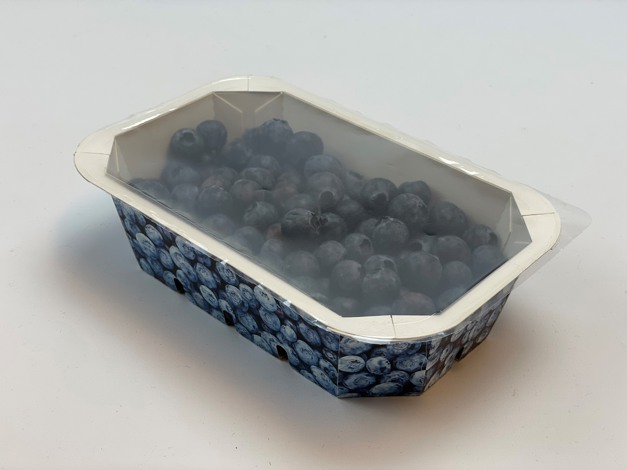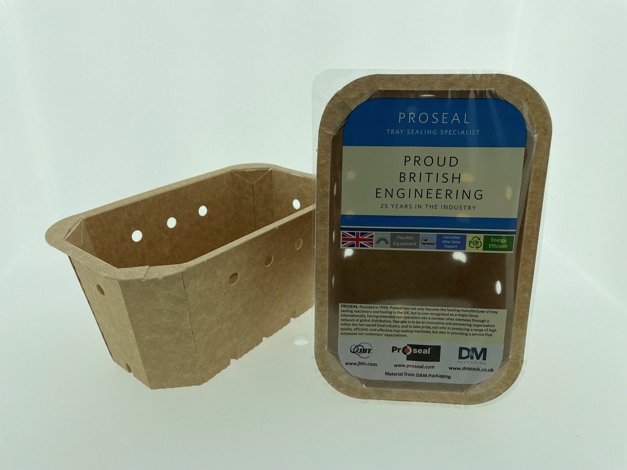The cardboard vs plastic issue remains a hot topic in the fruit and vegetable sector. For a long time, many markets seemed to be heading for a total plastic ban. But since recyclable plastic solutions are increasingly being introduced, that debate is set to continue for some time. Stackpack’s Ronald Zwaga advocates switching to cardboard solutions, and by introducing his new inline machine for topsealing self-made cardboard trays, he hopes to make that move easier for companies. "It took longer than expected or planned, but by using this new machine, companies can quickly topseal cardboard trays onsite," Ronald begins.

Stackpack partnered with Zalpak, which focuses on topseal solutions for fruit. "Zalpak has been producing cardboard fruit and vegetable trays for years and is a big player in conical trays." Besides Zalpak, Ronald and his partners started Halopack 12 years ago. Halopack manufactures gas-tight cardboard topsealed trays. By combining fruit and vegetable trays and topsealing, Stackpack was created five years ago. Ronald provides solutions for tomatoes, cucumbers, soft fruit, and, for instance, dates and herbs. Stackpack has since received the patent - for which it had to wait four years - for its self-developed trays. Now, by introducing its new inline machine, producing the new trays has also been simplified.
"What differentiates these trays is that the seal rim is very tight, which keeps the foil taut. With cardboard, topseal edges often lift when you stack them; we looked for a way to keep those down. Successfully, too; the first version was developed and has been on the market for several years. You must, however, keep tension on the adhesive flaps, and usually can't keep all four edges down. We solved that by connecting the corners during top sealing, thus keeping all four seal flanges down. That works and only requires some extra sealing time. Also, research in England shows that this cardboard solution even improves a product's shelf life by 71%," says Ronald.

"In 2019, we started manufacturing these solutions on existing machines. The disadvantage, though, was that clients had to purchase a new sealing machine to topseal these cardboard trays. Also, we have many long-distance clients, such as in the United States and Australia, who place large orders. So, we had to send everything in containers. The sealing took quite a long time, too, because the machine, which requires truly skilled workers to handle it, had to finish part of the packaging first."
Inline machine
Those were all reasons for the company to start working on a new, simpler inline machine, which companies across the globe could use to make their own packaging. "We wanted a machine we could place in line at companies. One that a handy worker could easily operate. Plus, companies can then source their cardboard locally. This new machine makes topsealing far easier, saving considerable sealing time," Zwaga says.
It took longer than anticipated, but several weeks ago, Stackpack could finally introduce this inline machine. It can also handle the other two packaging this company developed. "We now have an inline and offline solution, where the corners are glued together and with the unique feature that the film remains taut. Though the machine's not faster than the previous one, it's more reliable, and companies can save labor. Before, an operator had to concentrate on one machine fully; now, a capable worker can handle two."
Inevitable switch to cardboard
However, the machine's most significant advantage, says Ronald, is allowing companies to topseal packaging onsite. "Of our current production, 25% goes to the U.S., where 'domestic suppliers' are essential. With the rollout of this machine, it's now much easier to find local partners who make the packaging, which the companies can then topseal. We're already working with an Australian partner who's started working on this," Ronald explains.
Ronald finds it hard to say if developing this new machine will ensure an en masse switch to cardboard. "There's already plenty of interest to view the machine. People want to see if they can begin producing packaging locally. Cardboard is, however, considered differently per country. It's already far more established in the fruit and vegetable sector than in, say, the meat or fish ones. Each market transition rate differs, too. England, Belgium, Germany, and France are doing very well."

"In Germany, for example, your packaging may only contain five percent plastic; in France, that's zero percent. We have solutions for that, too. I also expect a lot of interest from the United States, with its many 'green states.' Those are important markets for us. In the Netherlands, though, the transition is a little slower to get going. I believe everyone should prepare for the approaching eventual transition to cardboard. It just remains to be seen how fast that happens," Ronald concludes.
Ronald Zwaga
[email protected]  Stackpack
Stackpack
Sluiskade Noordzijde 82
7602 HV Almelo
+310651558464
[email protected]
www.stackpack.eu
